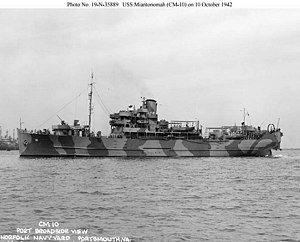
| |
| History | |
|---|---|
| Name |
|
| Builder | Pusey & Jones Corp., Wilmington, Delaware |
| Laid down | 26 May 1937 |
| Launched | 15 February 1938 |
| Acquired |
|
| Commissioned | 13 November 1941 |
| Renamed | Miantonomah, 14 May 1941 |
| Reclassified | CM-10, 15 May 1942 |
| Identification |
|
| Honors and awards | 2 Battle Stars |
| Fate | Sunk, 25 September 1944 |
| General characteristics [1][2][3] | |
| Type | Cargo ship / Auxiliary minelayer |
| Tonnage | 3,056 GRT, 1,900 DWT, 1,893 Net |
| Displacement |
|
| Length |
|
| Beam | 48 ft 6 in (14.78 m) |
| Draft |
|
| Propulsion | 2 x boilers, 1 GE cross compound turbine, 4,000 hp, single shaft |
| Speed | |
| Capacity | Cargo, as built: 190,500 cubic feet (5,394.4 m3) |
| Complement | 202 |
| Armament | 2 × 4 in (100 mm) guns, 4 × machine guns, 1 × depth charge track |
USS Miantonomah (CM-10/CMc-5) was built as SS Quaker by Pusey & Jones Corporation, Wilmington, Delaware in 1938 as a commercial coastwise ship operating as a fast inland water passenger and freight carrier. Quaker was acquired by the Navy in May 1941 for conversion to a coastal minelayer. Miantonomah operated off the east coast of the United States, Africa and the Mediterranean and took part in the invasion of Europe in 1944. The ship was sunk by a mine 25 September 1944.[3]
- ^ Cite error: The named reference
PMR538was invoked but never defined (see the help page). - ^ Cite error: The named reference
MVUS41was invoked but never defined (see the help page). - ^ a b Naval History And Heritage Command (August 10, 2015). "Miantonomah I (CMc-5)". Dictionary of American Naval Fighting Ships. Naval History And Heritage Command. Retrieved 1 November 2020.